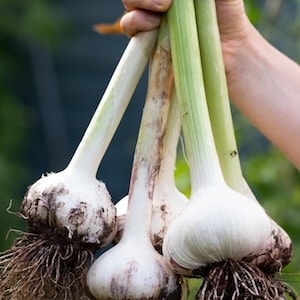What to do in your allotment in November
Written by Lee Senior
With long, dark evenings upon us, allotment time is greatly reduced. Luckily, nature is clever and the tasks that need doing are conveniently reduced too! That said, there’s no better time to take on a brand new plot or plan changes to your current one. Make the most of any dry days to redesign your growing space, create paths and build raised beds.
During November, winter digging and clearing overgrown patches of land are my priority tasks. This gives the frost plenty of time to gradually break down the freshly dug clods, and by next spring it should have become a fine tilth. I’ll also be cutting the foliage of my asparagus plants to ground level now it’s turning yellow. This tired foliage has served its purpose, and I don’t want it blowing around and loosening the soil around the roots.
While tidying up, I also like to make a hedgehog pile with fallen branches and twigs. These timid creatures are in decline and appreciate a safe shelter. And I’m always happy to encourage guests who get rid of slugs! Happy growing.

Image: Tulip ‘Everlasting Mixed’
Allotment flowers in November
- There’s still time to sow sweet pea seeds. Move your trays into a cold frame or an unheated greenhouse to germinate and grow over winter. They will produce flowers earlier than those sowed in the spring.
- There’s still time to plant spring flowering bulbs in pots and in the ground around the marginals of your plot – especially tulips. Perfect for tricky parts of the allotment, these unfussy flowers should go into the soil at a depth twice their own height.
- Dwarf ‘Pot Mums’ (Chrysanthemums) are looking good right now. They’re generally grown in pots and flower profusely in October and November until the first frosts. Although they’re not frost hardy, cuttings can be taken.
- Jasmine Nudiflorum is a winter-flowering climber that blooms from January. However, in sheltered, mild areas the plant will come into flower by late November. The bright yellow petals make a fine sight on the leafless green stems intertwined through trellis.
Allotment vegetables in November
- Continue to sow overwintering broad beans like ‘The Sutton’ in the cold frame or a cold greenhouse ready to plant out in early spring. Deep rootrainers are great as they minimise root disturbance when planting out.
- Winter hardy broad beans like ‘Aquadulce Claudia’ and ‘Luz de Otono’ can be direct sown into unfrozen beds and covered with a cloche or fleece.
- Sow hardy pea ‘Douce Provence’ and keep them in a cold frame or an unheated greenhouse. You can plant these out in March for an early crop.
- Plant garlic through November as long as the ground isn’t frozen. Use netting to cover your cloves until they root to prevent birds pulling them up.
- Plant onion sets in November for harvesting next summer. Cover them with a net to keep them safe until they root. Shallots are a great addition to the veg patch too, try traditional ‘Griselle’ for a spicy flavour or banana shaped ‘Longor’ if you prefer a sweeter, pink-tinged bulb.
- Cut back your yellowing asparagus foliage, if you haven’t already.
- Mustard leaves can be sown this month and are easy to grow in a cold greenhouse. I like to harvest them as baby leaves which are packed full of freshness and flavour.
- Sow kale shoots seeds alongside pea shoots ‘Twinkle’ for quick windowsill crops at home. The leaves are lovely in salads and sandwiches.
- Remove the lower leaves from your Brussels sprouts as they start to yellow to improve airflow.
- Sow hardy winter lettuce ‘Brighton’ under cloches or in grow bags in an unheated greenhouse. This variety produces large buttery heads, which are suitable for picking whole or using as a ‘cut and come again’ crop.
- Sow a few rows of the heritage radish ‘Black Spanish Round’ under cloches. You’ll get a tasty winter crop two months after sowing.
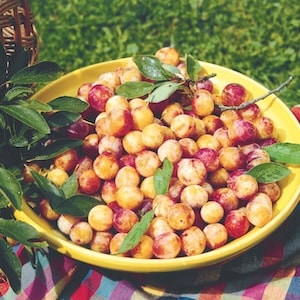
Image: Mirabelle Tree – de Nancy
Allotment fruit in November
- Bare root fruit tree planting season starts now. The dormant season is a good time to revamp tired beds or even create a new fruit garden. Well-drained soil rich with organic matter is desirable but even poorer soils can be improved gradually with the addition of copious amounts of well-rotted manure, leaf mould and compost. Remember there are plenty of grafted and dwarf fruit trees if space is at a premium.
- Consider planting nut trees on the allotment. Hazelnut trees provide screening as well as a crop of edible nuts.
- Check your rhubarb crowns for any signs of rot. Remove any slimy leaves from the crown. If the crown is getting very large, earmark it for splitting early next spring.
- Prune autumn-flowering raspberries hard, almost back to ground level.
- Keep a regular check on apples or pears in storage and remove any that show signs of rot. Make chutney with any surplus tomatoes that are not going to ripen.
Crops to harvest in November
- Hardy winter cabbage, carrots, cauliflower, Jerusalem artichokes, kale, leeks, turnips and swede are all ready to pick over the next few weeks.
- I still have beetroot, radish and lettuce to harvest.
- Dig up the last of your maincrop potatoes.
- Pick your pears and bring them indoors to ripen.
- Check over your stored crops, especially onions, potatoes and squashes for signs of softness or mould. If you find any decay, remove them from storage and eat or discard.
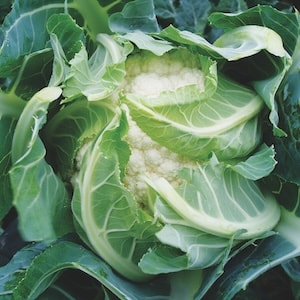
Image: Cauliflower ‘Sapporo’
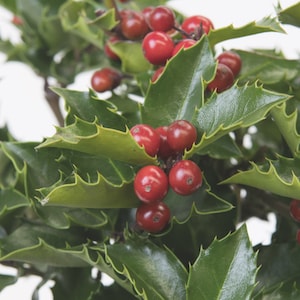
Image: Holly Standard Blue Maid
General November allotment jobs
- Start the big jobs you’ve been putting off during the busy summer months, like maintenance, tidying and clearing.
- Double dig your empty beds. The bigger clods will break down to create a fine tilth with repeated winter frosts, perfect for spring planting. If you live near the coast, gather dead seaweed to use as a free soil improver over winter.
- Cover young plants with frost protection fleece this month.
- Prepare a special climbing bean trench now by digging a deep ditch and filling it with vegetable scraps and organic matter. It will rot down over winter and spring, providing warmth and nutrients for your bean seeds to get a head start.
- Raised beds warm up quicker and drain better than regular beds, so ear-mark them for planting broad beans or lettuce for your first spring crops. Try making your own using pallets or old planks for a fun winter project.
- Check your netted brassicas regularly, ensuring they’re fully covered to keep the birds away. Do the same for your covered autumn planted garlic, onions and shallots.
- Make a pile of leaves to rot down in a corner. You’ll have nutrient rich leaf mould in around 12 months. Use a petrol powered lawn mower to pick them up if you can. This shreds the leaves and speeds up their decomposition.
- Bare root native trees or spiky varieties like holly are best planted now. Perfect for benefitting wildlife or increasing security on your plot. You can even get a crop from certain types, like sloes from thorny blackthorn.
- Spare a thought for hedgehogs. Check before lighting any bonfires, put a hedgehog house in a quiet corner of your plot or leave a messy area over winter. They’re great allies in the fight against slugs and snails.
Planning ahead
- As the days darken and get colder, find a comfy armchair and start next year’s crop planning! Sketch everything out on paper, and mark down sowing and planting dates on a calendar. It pays to be organised when you come to order your seeds for next year.
- Check you have plenty of frost protection gear and netting to keep young plants healthy over the coming months.
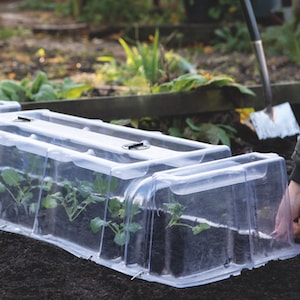
Image: Mini Greenhouse Cloche
Suttons Seeds recommend these areas which may also be of interest.
- Previous month: What to do in your allotment in October
- Next month: What to do in your allotment in December


